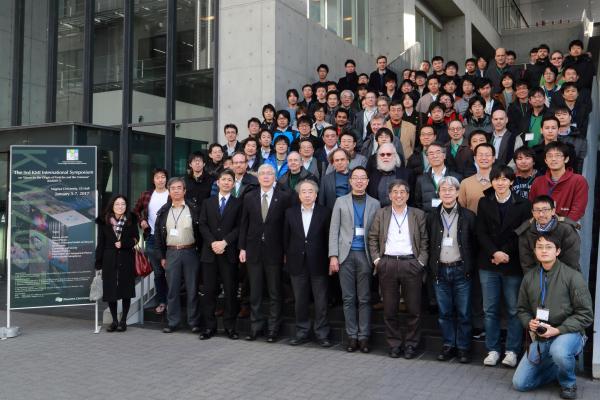About KMI
Humans have always sought to understand and explore the origins of matter and the universe. At Nagoya University, the foundation of innovative research in particle physics was first established by Dr. Sakata and his colleagues in the early days of the university. Ever since then, at Nagoya University, there were many outstanding achievements in this field, such as two-meson theory, the Sakata model, and Maki-Nakagawa-Sakata theory. Such achievements have lead to the establishment of Kobayashi-Maskawa theory, for which Drs. Kobayashi and Maskawa were awarded the Nobel Prize in Physics in 2008. In addition to these theoretical efforts, various experimental research projects, conducted from the early stages, have been producing first class results, including the discovery of the charm quark and the tau neutrino, as well as confirmation of Kobayashi-Maskawa theory by the B-factory experiments. They are key experiments in establishing the Standard Model.
The Kobayashi-Maskawa Institute for the Origin of Particles and the Universe (KMI) has been established with the objective of further promoting this brilliant tradition of Nagoya University, and to explore new frontiers of modern physics beyond the Standard Model. This is being achieved by integrating the wisdom of researchers in various fields of physics such as theoretical and experimental particle physics, theoretical and observational astrophysics, mathematical physics, and cosmic ray physics, who are affiliated with the Graduate School of Science, the Graduate School of Mathematics, and the Solar-Terrestrial Environment Laboratory at Nagoya University, as well as by incorporating techniques of computational physics into theoretical particle physics. We are intensively pursuing the creation of a new paradigm in physics under the leadership of Dr. Maskawa, the director general of KMI, who is full of new and novel ideas.
In particular, new discoveries in particle physics, which would be evidence of physics beyond the Standard Model, are expected to be made in the coming years, resulting in a revolution in particle physics which will allow us to elucidate the origin of elementary particles. These discoveries will also shed light on dark matter and dark energy, which have been the subject of intense study in astrophysics and cosmic ray research for many years. These discoveries will also shed light on the origin of the universe and space-time, resulting in enormous impacts in these fields.
Particle physics experimentalists who participate in KMI are key researchers leading front-line experiments such as the OPERA neutrino oscillation experiment, the LHC experiment at CERN, and the Super B-factory experiment at KEK. Through these experiments we are expecting to discover new phenomena beyond the Standard Model. In addition to experimental work, particle physics theorists at KMI are playing a leading role in constructing and investigating new physics models beyond the Standard Model, as well as in exploring the dynamics of the Standard Model and string theory. We are also further pursuing theoretical research by employing techniques of computational physics. Researchers in theoretical and observational astrophysics, cosmic ray physics, and mathematical physics are also conducting world-leading research through their own unique projects.
In conclusion, KMI is aiming to be a research organization with dynamism, through the integration of the world-class talents present at Nagoya University and through close collaboration with leading theoretical and experimental groups.
